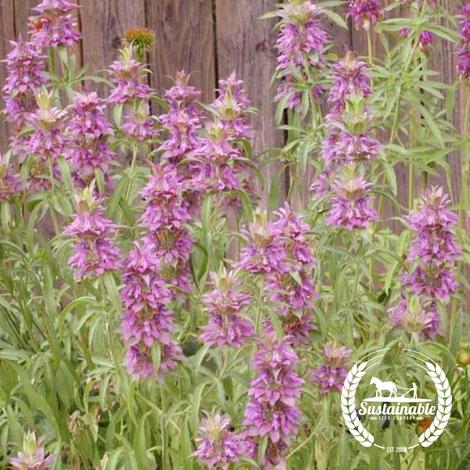The information on this page only applies to seedlings sold by Fremont LEAF Nursery during our Annual Spring Seedling Sale 2021.

Monarda citriodora. This annual wildflower is native to midwest but grows from California to Florida. It naturally inhabits prairies and roadsides. Bee balm is easy to establish, and readily reseeds each year. As the name implies, the foliage smells lemony (turning more reminiscent of oregano late in the season) and the large, purple/pink, sage-like flowers attract hummingbirds, bees and butterflies.[1]
Seed Type
| Organic | Heirloom | Non-GMO | Hybrid | Open-pollinated | Untreated |
Additional Information
| Container Friendly | Trellis Needed | Easy to Grow | Pollinator Friendly |
When to Plant Your Seedling
| Jan | Feb | Mar | Apr | May | Jun | Jul | Aug | Sep | Oct | Nov | Dec |
Growing Conditions
| Light | Temperature | Soil | Water |
|---|---|---|---|
| Full Sun to part shade | 60-70 F | Well-drained, prefers high clay content but not waterlogged. Soil pH: 6.6-7.8 | Prefers relatively dry soil after roots well established |
Planting Tips
| Plant Spacing | Plant Size | Days to Maturity |
|---|---|---|
| 36" |
- Additional instructions: Easily grown in average, dry to medium moisture soils in full sun to part shade. Prefers limestone-rich, rocky or sandy soils, but tolerates other soils. Prefers full sun. Plant seed in fall or early spring. This plant will remain in the garden from year to year by self-seeding. Plants may form large colonies in optimum growing conditions.[2]
- Monarda citriodora, commonly called lemon mint, lemon beebalm, lemon horsemint, purple horsemint or lemon bergamot, is a hardy annual (sometimes biennial) that is typically found in rocky or sandy prairies, pastures and roadsides from South Carolina and Florida west to Missouri, Texas and Mexico. In Missouri, it primarily occurs in limestone glades, dry limestone ledges, bald knobs and rocky prairies in certain counties south of the Missouri River (Steyermark). It grows 12-30” tall. Tubular, scented, two-lipped, light lavender to pink to white flowers bloom in dense, globular, head-like clusters (verticillasters or false whorls) from spring to mid-summer (May-August in St. Louis). Flower clusters appear on stiff square stems clad with narrow lanceolate to oblong, awn-tipped, serrate leaves (to 2.5” long). Upper stem leaves may be in whorls. Each flower stem typically has 2 to 6 interrupted flower clusters, with each cluster being subtended by white to pink-lavender bracts. Flowers are attractive to bees, butterflies and hummingbirds, particularly when massed. Leaves have a distinctive lemony aroma when rubbed. Some monardas are commonly called beebalm in reference to a prior use of the leaves as a balm for bee stings..[2]
- Commonly used as a bedding plant, cottage gardens, herb gardens, native plant areas, prairies, roadsides or waste areas. Also effective in hummingbird or butterfly gardens. Leaves may be used to make herbal teas or may be added to pot-pourris.
- Harvesting instructions: Pick leaves when needed.
Common Diseases and Pests
- Powdery mildew[2]
Useful Resources
- https://sustainableseedco.com/products/lemon-bee-balm?variant=3171121954856(Seed Source)
- https://www.missouribotanicalgarden.org/PlantFinder/PlantFinderDetails.aspx?taxonid=281493
- https://sfbaygardening.com/resources/bay-area-planting-calendar/
If you bought this seedling and have any questions or feedback, let us know in the comment section below.